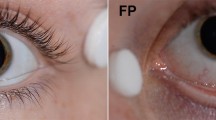Abstract
This study reports electroretinogram (ERG) data in a septuagenarian population. Fifty healthy adults without diabetes or dementia aged 70–79 years underwent standardised electrophysiological testing incorporating current ISCEV Standards as baseline assessment for the OPAL (Older People And n-3 Long-chain polyunsaturated fatty acids) study. These data were compared with those from 53 healthy adults aged 20–50 years. Amplitudes and peak times of the major components were assessed. There were no significant differences in amplitude or peak time between sexes or between eyes. ERG amplitudes were 25–40% smaller and peak-times were longer in the older compared with the younger age group. In all participants, the bright flash ERG b-wave amplitude had the highest variability; the bright flash ERG a-wave peak time had the lowest. ERGs in a septuagenarian age group show 25–40% lower amplitude than those of a 20 to 50-year-old group and are of longer peak time. With an increasingly ageing population involved in clinical trials, and the potential use of ERG in the assessment both of efficacy and safety in forthcoming therapeutic interventions, it is important that the effects of age are given adequate consideration.



Similar content being viewed by others
References
Weleber RG (1981) The effect of age on human cone and rod ganzfeld electroretinograms. Invest Ophthalmol Vis Sci 20(3):392–399
Birch DG, Anderson JL (1992) Standardized full-field electroretinography. Normal values and their variation with age. Arch Ophthalmol 110(11):1571–1576
International Standardization (1989) Standard for clinical Electroretinography (1989). Arch Ophthalmol 107:816–819
Birch DG, Hood DC, Locke KG, Hoffman DR, Tzekov RT (2002) Quantitative electroretinogram measures of phototransduction in cone and rod photoreceptors: normal aging, progression with disease, and test-retest variability. Arch Ophthalmol 120(8):1045–1051
Marmor MF, Holder GE, Seeliger MW, Yamamoto S (2004) Standard for clinical electroretinography (2004 update). Doc Ophthalmol 108(2):107–114
Marmor MF, Fulton AB, Holder GE, Miyake Y, Brigell M, Bach M (2009) ISCEV Standard for full-field clinical electroretinography (2008 update). Doc Ophthalmol 118(1):69–77
Dangour AD, Clemens F, Elbourne D, Fasey N, Fletcher AE, Hardy P, Holder GE, Huppert FA, Knight R, Letley L, Richards M, Truesdale A, Vickers M, Uauy R (2006) A randomised controlled trial investigating the effect of n-3 long-chain polyunsaturated fatty acid supplementation on cognitive and retinal function in cognitively healthy older people: the older people and n-3 Long-chain polyunsaturated fatty acids (OPAL) study protocol [ISRCTN72331636]. Nutr J 5:20
Dangour AD, Allen E, Elbourne D, Fasey N, Fletcher AE, Hardy P, Holder GE, Knight R, Letley L, Richards M, Uauy R (2010) Effect of 2-y n-3 long-chain polyunsaturated fatty acid supplementation on cognitive function in older people: a randomized, double-blind, controlled trial. Am J Clin Nutr 91(6):1725–1732
Bird AC (2010) Therapeutic targets in age-related macular disease. J Clin Invest 120:3033–3041
Grisanti S, Tatar O (2008) The role of vascular endothelial growth factor and other endogenous interplayers in age-related macular degeneration. Prog Retin Eye Res 27:372–390
Curcio CA, Millican CL, Allen KA, Kalina RE (1993) Aging of the human photoreceptor mosaic: evidence for selective vulnerability of rods in central retina. Invest Ophthalmol Vis Sci 34(12):3278–3296
Marshall J, Grindle J, Ansell PL, Borwein B (1979) Convolution in human rods: an ageing process. Br J Ophthalmol 63(3):181–187
Kessel L, Lundeman JH, Herbst K, Andersen TV, Larsen M (2010) Age-related changes in the transmission properties of the human lens and their relevance to circadian entrainment. J Cataract Refract Surg 36(2):308–312
Dillon J, Zheng L, Merriam JC, Gaillard ER (2004) Transmission of light to the aging human retina: possible implications for age related macular degeneration. Exp Eye Res 79(6):753–759
Dorey CK, Wu G, Ebenstein D, Garsd A, Weiter JJ (1989) Cell loss in the aging retina. Relationship to lipofuscin accumulation and macular degeneration. Invest Ophthalmol Vis Sci 30(8):1691–1699
Gao H, Hollyfield JG (1992) Aging of the human retina. Differential loss of neurons and retinal pigment epithelial cells. Invest Ophthalmol Vis Sci 33(1):1–17
Curcio CA, Medeiros NE, Millican CL (1996) Photoreceptor loss in age-related macular degeneration. Invest Ophthalmol Vis Sci 37(7):1236–1249
Katz ML, Drea CM, Robison WG Jr (1987) Age-related alterations in vitamin A metabolism in the rat retina. Exp Eye Res 44(6):939–949
Gresh J, Goletz PW, Crouch RK, Rohrer B (2003) Structure-function analysis of rods and cones in juvenile, adult and aged C57bl/6 and Balb/c mice. Vis Neurosci 20(2):211–220
Curcio CA (2001) Photoreceptor topography in ageing and age-related maculopathy. Eye 15(Pt 3):376–383
Jackson GR, Owsley C, Curcio CA (2002) Photoreceptor degeneration and dysfunction in aging and age-related maculopathy. Ageing Res Rev 1(3):381–396
Acknowledgments
The funding for the OPAL study was provided by the United Kingdom Food Standards Agency (NO5053). The United Kingdom National Health Service Research and Development provided service support costs. Funding was also provided by the National Institute for Health Research UK to the Biomedical Research Centre for Ophthalmology based at Moorfields Eye Hospital NHS Foundation Trust and UCL Institute of Ophthalmology.
Author information
Authors and Affiliations
Corresponding author
Additional information
On behalf of the OPAL study team.
Rights and permissions
About this article
Cite this article
Neveu, M.M., Dangour, A., Allen, E. et al. Electroretinogram measures in a septuagenarian population. Doc Ophthalmol 123, 75–81 (2011). https://doi.org/10.1007/s10633-011-9282-1
Received:
Accepted:
Published:
Issue Date:
DOI: https://doi.org/10.1007/s10633-011-9282-1




